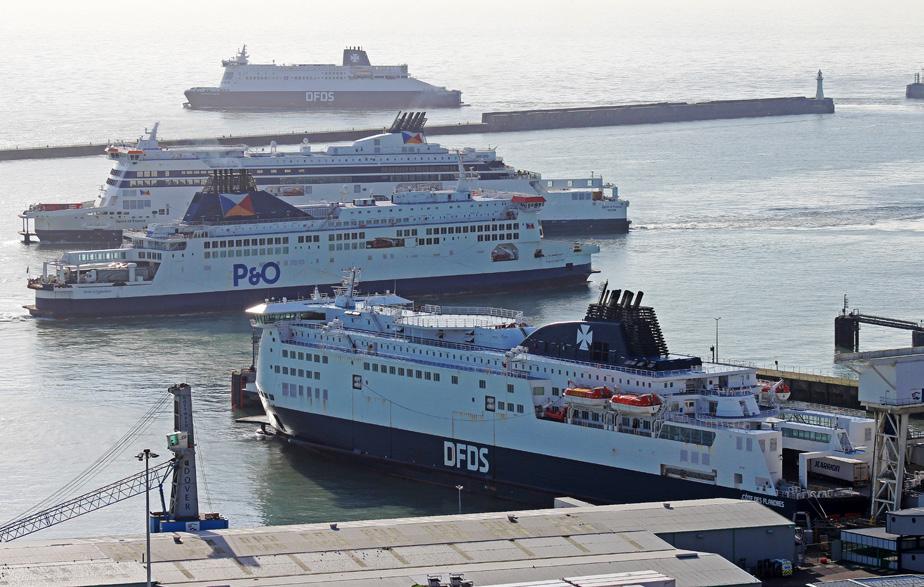
8 minute read
Dover Agenda
THE DOVER AGENDA
Doug Bannister, CEO, Port of Dover, UK talks one-on-one with Felicity Landon and spells out the port’s frustrations, challenges, projects and aspirations
Doug Bannister, CEO, Port of Dover, wants the UK government to get a grip on the implementation of new biometric controls which he fears could cause more upheaval next year.
Dover would get the blame for any delays, says Doug Bannister. “But we can’t prepare for something we don’t know.”
The freight and passenger ro-ro port has been settling down since the mega-queues in July (2022) which kept Dover in the headlines. It’s two years since the Christmas chaos when France closed its borders to stop the spread of Covid. As he says, the port remained open and operating through Brexit, Covid, French border closures and summer getaway weekends, “and that that has meant that the nation keeps the supplies rolling”.
However, now another major headache is on the horizon – the implementation of new biometric controls. The EU’s new border control IT system, EES (Entry/Exit System) is due to be implemented in May 2023.
This will require anyone entering the EU – drivers and passengers alike – to register fingerprints and a photo with their passport details. Dover has already had to adapt to post-Brexit requirements for British travellers’ passports to be stamped, not just waved through by the French border police (Police aux Frontières, or PAF). The EES has been on the cards for four years, says Bannister – but the details have yet to be specified.
“There will be two stages to the process. Registration, when you have your biometrics put into the system alongside your passport, by a police officer. Validation – every time you cross the border, your biometrics will be validated. The challenge is that we don’t know anything about this process – it hasn’t been defined and the technology hasn’t been tested or trained on. So, we are in a period of the unknown.”
Dover has heard that registration will take two minutes per passenger and two minutes per car; that, of course, translates into more than 10 minutes for one car carrying four people.
The current process for stamping passports takes 1.5 minutes per car. “In an operation where we talk about shaving seconds off, this will have a material impact,” says Bannister.
There have even been suggestions that the process would require passengers to present themselves in a queue at the kiosk. “Imagine – late night, raining, people asleep in the back of the car. We can’t allow people to exit the vehicles in the busy lanes – it is too dangerous. This process needs to be done while people are in their cars.”
As 70-80 per cent of truck drivers passing through Dover are EU nationals, this side of the operation should be smoother; but given that 80 per cent of tourists are British, the implications are clear. At the end of the day, gridlock for one is gridlock for all.
“We are facing implementation in May next year but we still don’t know exactly what it is going to be,” says Bannister. “There is little that the port itself can do – all we do is host the process. It is an EU-defined process and their relationship with the UK is via the Home Office. While we can tell them what will/won’t work, we need our government to work with the French government and the EU. We need our government to grip this issue and work with the French and EU authorities to deliver a solution that will work for a fast turnround ferry port.”
As he notes, May is not the best time – just as tourist travel
8 The velocity
model – Dover turns its berths over 10 times a day and its land six times a day
New biometric controls are a looming problem with little clarity from government ‘‘ about the new arrangements and IT systems to be deployed
is cranking up for the peak season. There may be a soft landing or transition period which could help, “but we need to know – what are the rules of the game, what’s the technology, who will operate the technology and do we have to train people on it?”
Dover has been highlighting this as an issue for years, says Bannister. The EES will have its impact on destination ferry terminals and airports in Europe, but Dover is unusual because of the system of juxtaposed border controls, which means entry to France is controlled on the UK side. The benefit of that is that all the processes are upfront, before travel; the disadvantage is that Dover hosts two lots of potential delay. “Elsewhere, when you take a flight, for example, you turn up two hours before, drop bags, go through security, wait, get on the plane. On the other side, you get off the plane, go through immigration, get your passport stamped, and so on.” People should look at the ‘end-to-end’ disruption of a journey in order to make a fair comparison.
THE VELOCITY MODEL
Bannister underlines, Dover’s business model is based on ‘velocity’. “The main reason that the market has chosen this route is the efficiency we have. Our ferries can complete up to five round-trips a day. We turn our berths over ten times every day and turn over the land six times a day. Looking at capacity, we don’t have the geographical footprint of other ports. Felixstowe, the UK’s largest container port, handles about 4.5mTEU a year, operating on about 400 hectares including roads, buildings, quays, etc. We do 2.5m trailers – the equivalent of 5.5mTEU – through our facility and our ferry terminal has a footprint of 40 hectares. The key thing is velocity – we look to shave minutes and seconds off each movement. We look at everything – routes, roads, sister ports, anything that could affect us.”
Some 11m passengers pass through Dover in a year – equivalent to the third or fourth busiest regional airport in the country, he points out. “And airports just do foot passengers; we do cars, caravans, taxies, bicycles, horse boxes, buses.”
Throughout post-Brexit planning, Dover made clear that it did not have room to build new border control post facilities, or to handle additional Customs documentation and paperwork. The full Customs checks were implemented from 1 January this year; the paperwork is done before arrival at the port but even so, there were delays for a couple of months when businesses were still getting accustomed to the requirements. “That has smoothed out now but we do know it is impacting the wider supply chain.”
The government built the Sevington inland border facility to serve the port and Eurotunnel, keeping BCP processes away from Dover.
Bannister says that in the July disruption, the port was back to normal after 36 hours; even in the Christmas 2020 chaos, when there were 3500 trucks waiting at Manston, the backlog was cleared within a week. “The message is that while there may be queues on very busy travel days, the resilience and capacity of the port is such that we clear the backlog very swiftly,” he says.
The port and all of its staff have had a ‘pretty challenging period’. Bannister says he has ‘extreme pride’ in the port and its people. “Whether harbour board or stevedores, ferry operators or Border Force – everyone’s whole ethos, DNA, is to keep the traffic moving. When the chips are down, everybody rallies.”
The Port of Dover has invested £200,000 in new infrastructure to smooth processes for trucks and passenger traffic – and it wants to move forward with a £50m-plus project to relocate and reorder the border control plaza deeper into the port. “This is a huge project and we are still talking to the government about funding,” says Bannister.”

LOOKING AHEAD
There is no doubt that Dover was very internally focused during the Brexit period and Covid-19 pandemic, says Bannister. “But in the past 12 months, we have been starting to lift our head and look forward.”
In April 2022, the port released its sustainability agenda. It has set a target for net carbon zero port operations by 2025 and has already converted all its landside vehicles and assets from diesel to HVO, and it is working on plans to become part of the UK’s first ‘green logistics corridor’, extending the focus to emissions from ferries and vehicles in the supply chain.
“We are taking firm control of our leadership position as the premier port in the UK; one-third of all trade with the EU comes through our facility,” notes Bannister. “We have pulled together a powerful coalition – ferry operators, sister ports in France, local, regional and central government in the UK, regional government in France, and academics including at the University of Kent. We benefited from a grant from the Clean Maritime Demonstration Competition. Now we are in the process of securing about a million pounds in round two [of CMDC], to help us understand what it is going to take to achieve our goals.”
A big focus is on future power requirements, not only for cold ironing but for recharging the electric ferries of the future. It has been established that Dover needs 4 MW for present operations – while the total capacity coming into the Dover region is 8 MW “and a lot of it is consumed”, says Bannister. If cruise ships were to ‘plug in’ for onshore power, 7-11 MW would be required. To recharge electric ferries, trucks and equipment, the figure jumps to 150 MW.
CMDC1 gave “the frightening numbers and clarity” while CMDC2 will consider “how do we provide it”, says Bannister.
“Could we go for hydrogen instead of electric? Maybe the ferries could go fuel cell or methane. But no matter what it is going to be, it will be a complete change of infrastructure to deliver energy to the port.”
8 “In the past 12








